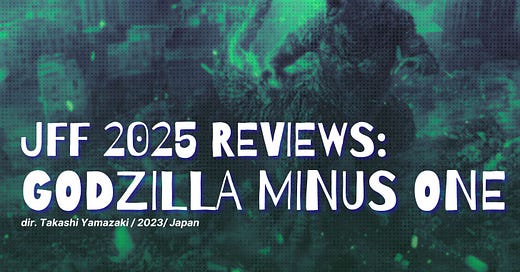Godzilla Minus One (2023) Review
“Because… my war isn’t over yet” is a telling line in Godzilla Minus One. Whatever makes the film fascinating, and also problematic, is encapsulated here. It is spoken by the protagonist Shikishima (played by Ryunosuke Kamiki), a former World War II kamikaze pilot, when asked about failing to marry a romantic interest. Much of this kaiju film actually dedicates itself to Japanese daily life in the aftermath of World War II. The focus on human characters and drama in the films of this decades-long franchise has met some derision; viewers understandably prefer the big monster fights. The blockbuster American versions in 1998 and 2014 are the most guilty of such criticism. Godzilla Minus One stands out because it takes its time to actually be invested in the psychology of its humans – and the wider post-war society the 1954 original reflected upon. For better or for worse.
The film opens with Shikishima retreating to a Pacific island air base, ostensibly for plane repairs. We soon learn his plane is in good condition. That night, Godzilla arrives on the island to do kaiju things. It is here we witness Shikishima hesitate to inflict violence on the enemy. Many Navy men are killed by the monster, while Shikishima survives, returning to a ruined Tokyo. The city is reduced to rubble not by the titular kaiju but by the Americans. Blamed for the deaths of his compatriots and his loved ones, Shikishima is haunted by his perceived cowardice, reliving the night of Godzilla’s island attack.
And then, the film spends 10 minutes kaiju-free as Shikishima atones for his sins, like a brooding Paul Schrader protagonist. He takes in a woman named Noriko (played by Minami Hamabe) and her adopted daughter Akiko (played by Sae Nagatani). They live together in Shikishima's initially ruined home as the city slowly rebuilds in the late 1940s. I really admire this whole sequence. It’s a direct statement on the destruction of the traditional Japanese household brought upon by the American bombing and occupation. None of the three are neither related to one another nor even known to each other before the war. Shikishima and Noriko do not marry nor consider themselves boyfriend-and-girlfriend. Shikishima even shows discomfort at young Akiko calling him “Daddy”. And yet, they stick together for survival in their impoverished lives. Here, the most thrilling scene is not one of escaping monsters or falling buildings but a domestic argument on whether or not Shikishima should take a dangerous minesweeping job to earn enough money for all three.
Once he gets the job and embarks on a Jaws-esque journey, the film proceeds in a typical monster adventure fashion. We meet Godzilla again, 20 minutes after his last appearance (sans dream sequence). Gunfire, boat chase, explosions. Then, a little later, city destruction. Men in rooms plotting hare brained schemes to trap and kill Godzilla. Blockbuster fun. This is where the film also takes on a meaner turn. You see the great thing about the 2014 American version is how it allows us to empathize with the monster, itself a victim of humanity’s capacity for nuclear violence. There is little room for sympathy for the titular character in Godzilla Minus One. Godzilla is simply another enemy and he must be destroyed with the same violence he was created with. The characters here fight fire with fire. As sympathetic as one can be towards Shikishima, his arc revolves around him mustering the courage to be violent and destructive towards the “inhuman”, to serve the empire.
Godzilla Minus One offers great thrills and insights to the human psyche in the aftermath of one of the deadliest wars in history. It’s a crowd-pleasing fare where epic visual effects designed by Kiyoko Shibuya make for a grand adventure, mixing intimate family drama and large scale science fiction battles, in the tradition of Steven Spielberg’s blockbusters. It’s worth seeing on the biggest screen possible, as I did for the opening night of the 2025 Japanese Film Festival in the Philippines. After all the excitement of action spectacle in the film, one hopes it shouldn’t be lost on the audience, what the implication of a potential never-ending war, which the protagonist reckons with, entails for a society where the threat of nuclear destruction (and even environmental disaster) has never left since the franchise began in 1954.
Catch Godzilla Minus One in select SM cinemas as part of the Japanese Film Festival 2025






